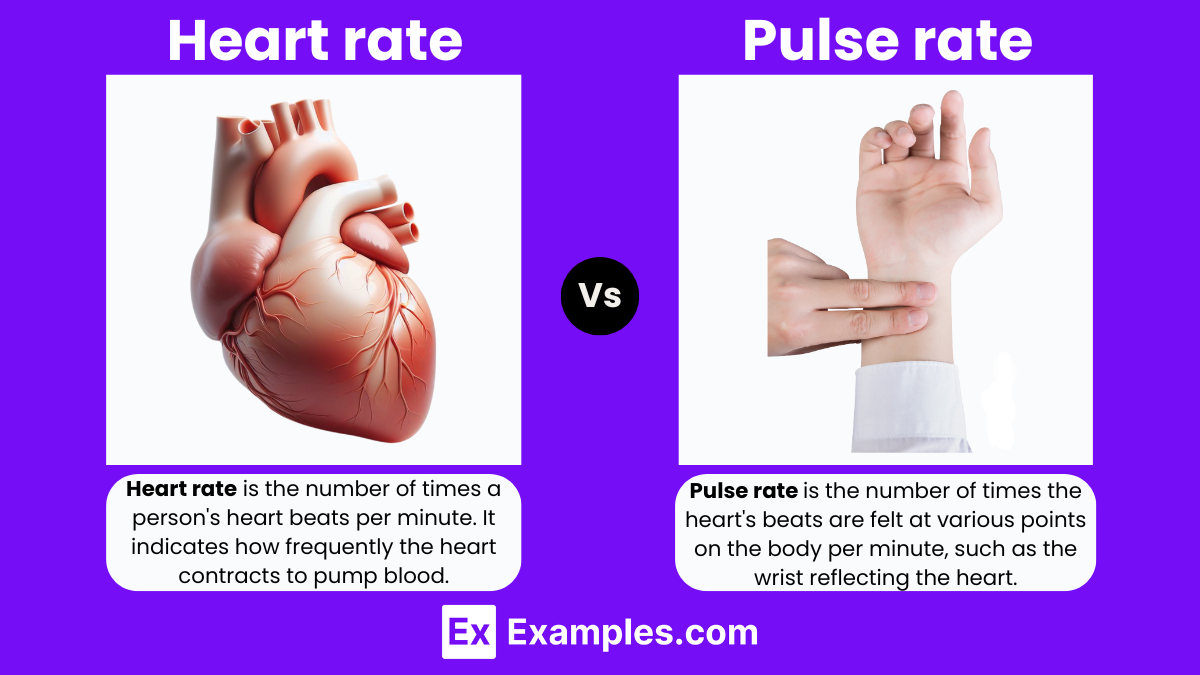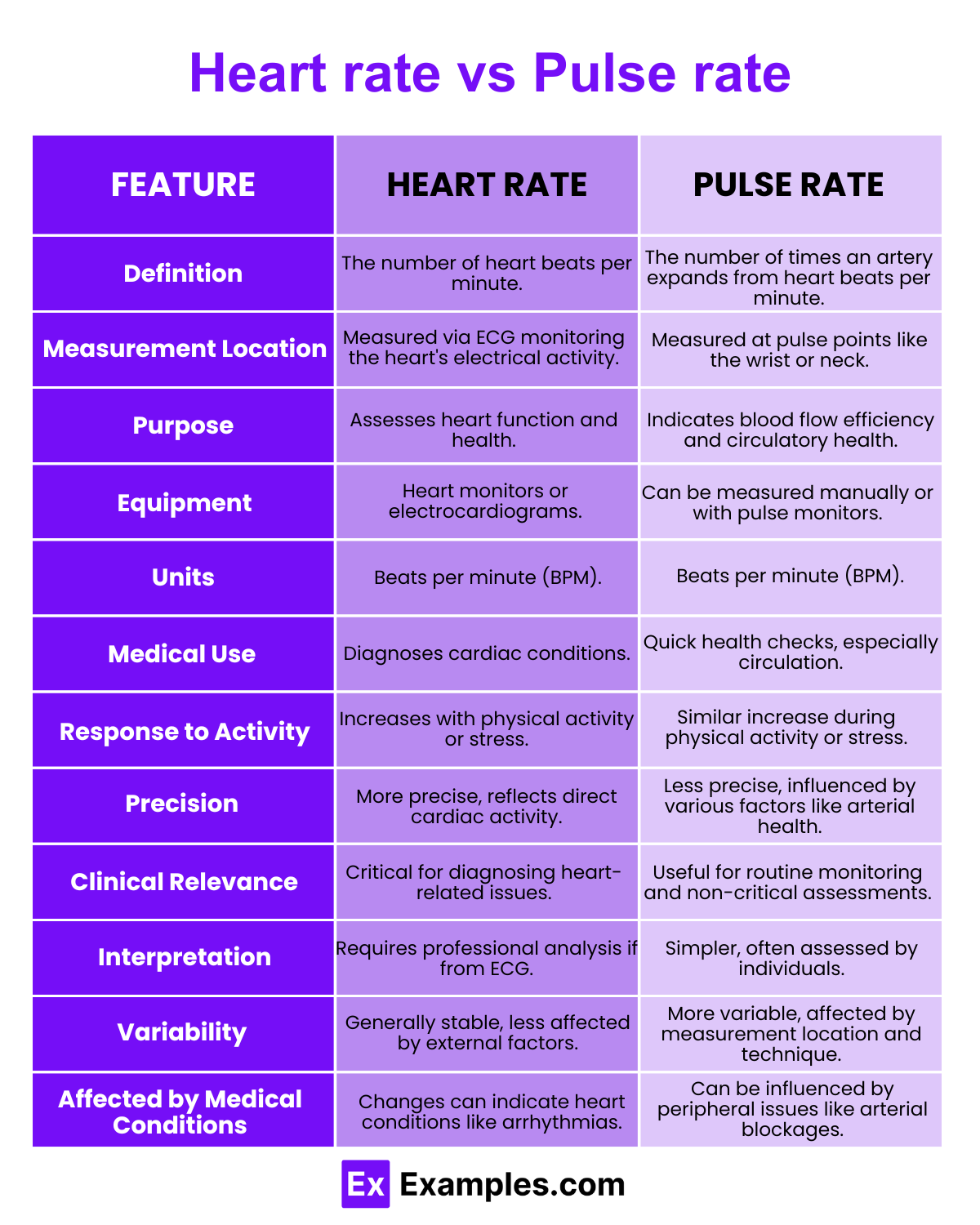What is the definition of heart rate?
The number of breaths per minute
The number of times the heart beats per minute
The pressure of blood against the artery walls
The number of muscle contractions per minute

Heart rate and pulse rate are vital indicators of health, often used interchangeably but represent slightly different aspects of cardiovascular function. Heart rate refers to the number of times the heart beats per minute, reflecting the heart’s activity and overall health. Conversely, pulse rate measures the frequency of pulses felt over arteries, indicating the rate at which the heart is pumping blood. Both metrics provide essential insights into cardiac efficiency and physical health, guiding medical assessments and fitness monitoring.
Heart rate is the number of times your heart beats per minute, indicating how hard your heart is working to circulate blood throughout your body. It can vary based on many factors, including age, fitness level, air temperature, body position, emotions, and physical activity. Monitoring heart rate is crucial for assessing cardiovascular health, determining fitness levels, and diagnosing potential heart-related conditions. Regular checks can help track changes over time, offering valuable data for maintaining or improving heart health.
Pulse rate is the number of times your arteries expand and contract in response to the heart pumping blood through them, measurable at any point on the body where an artery is close to the skin and can be felt. These points include the wrists, neck, and ankles. The pulse rate provides a direct insight into the rhythm and strength of your heart’s beats, serving as an important health indicator that reflects your heart rate and circulatory system’s condition.
The easiest places to find your pulse are on your wrist or neck.
Press lightly with your fingers until you feel the blood pulsing beneath your skin. If you can’t find it, move your fingers around slightly until you do.
Once you’ve located your pulse, count the beats for 30 seconds and then double the number to get your pulse rate in beats per minute (bpm). For a more accurate reading, count for a full minute.
Keep a record of your pulse rate readings to monitor any changes over time, especially if you are tracking your heart health or any medical conditions.

| Aspect | Heart Rate | Pulse Rate |
|---|---|---|
| Definition | The number of times the heart beats per minute. | The number of times the arterial pulse is felt per minute. |
| Measurement | Typically measured using an electrocardiogram (ECG) that records electrical activity of the heart. | Often measured manually by palpating arteries such as the wrist or neck. |
| What It Indicates | Reflects the frequency of heart contractions. | Indicates the frequency of pulses in arteries, reflecting heart beats. |
| Tools Used | ECG machines, heart rate monitors. | Fingers used for palpation, pulse oximeters. |
| Units | Beats per minute (bpm). | Beats per minute (bpm). |
| Clinical Use | Used to diagnose heart conditions, monitor cardiac health, and assess effects of drugs. | Used for quick assessments of heart rhythm and circulatory health. |
| Variations | May vary with conditions such as arrhythmias where there could be a heart beat without effective blood flow. | Generally matches the heart rate, but may differ if not all heartbeats result in a palpable pulse. |
| Accuracy | Considered more accurate in reflecting heart’s function as it measures electrical activity directly. | May be less accurate if pulses are weak or irregular. |
| Interpretation | Requires professional interpretation when using an ECG. | Can be easily measured by laypersons and health professionals alike. |
| Impact of Physical Activity | Increases with exercise, stress, and anxiety. | Increases similarly under the same conditions but can be affected by peripheral factors such as vessel stiffness. |
| Relation to Cardiac Output | Directly related to cardiac output, which is the volume of blood the heart pumps per minute. | Indirectly related, as it reflects the pulses felt, not the actual volume of blood pumped. |
| Significance in Medical Testing | More detailed evaluations of heart rate are essential in tests like stress tests and heart function studies. | Typically not used for in-depth cardiac diagnostic testing but is valuable in basic physical examinations. |
| Influencing Factors | Heart rate can be influenced by factors like temperature, body position, and emotional state. | Similar factors can influence pulse rate, along with arterial health and blood pressure. |
| Monitoring Consistency | Generally consistent when monitored under controlled conditions. | Can show variability due to measurement technique or peripheral circulation issues. |
Heart rate and pulse rate are often used interchangeably in everyday language, but they originate from closely related physiological processes. Here are the key similarities between the two:
Both heart rate and pulse rate measure the activity of the heart. Heart rate refers to the number of times the heart beats per minute, while pulse rate is the frequency at which one feels the heartbeats at various points on the body, such as the wrist or neck.
Both rates serve as crucial indicators of heart function and overall cardiovascular health. They help in assessing how fast the heart is beating, which can be critical for diagnosing and monitoring various health conditions.
Heart rate and pulse rate increase in response to physical activity. This rise helps to meet the higher oxygen and nutrient demands of the body during exercise or any physical exertion.
The autonomic nervous system, which controls involuntary bodily functions, regulates both the heart rate and pulse rate. Factors like stress, excitement, or relaxation can cause both rates to increase or decrease.
Both measurements are used routinely in medical assessments. They are critical in emergency settings, physical exams, and are key metrics in fitness tests to evaluate an individual’s health status and physical fitness level.
Yes, heart rate measures heartbeats per minute, while pulse rate is those beats felt at various body points.
Both normal pulse and heart rates typically range from 60 to 100 beats per minute for adults.
For adults: 60-100 bpm, children: 70-100 bpm, infants: 100-160 bpm; athletes may have lower rates.
An unhealthy pulse rate is below 60 or over 100 bpm at rest, indicating potential cardiac issues.
Signs include persistent coughing, swelling in extremities, fatigue, and shortness of breath during activities.
Text prompt
Add Tone
10 Examples of Public speaking
20 Examples of Gas lighting
What is the definition of heart rate?
The number of breaths per minute
The number of times the heart beats per minute
The pressure of blood against the artery walls
The number of muscle contractions per minute
What is the pulse rate?
The number of blood vessels in the body
The number of times the arteries expand and contract per minute
The number of red blood cells in a sample
The force of blood against the vein walls
Can heart rate and pulse rate be different?
Always
Never
Usually
Sometimes
Which device is commonly used to measure heart rate?
Sphygmomanometer
Stethoscope
Thermometer
Pulse oximeter
Where can you commonly measure the pulse rate on the body?
Elbow
Knee
Wrist
Ankle
How does exercise typically affect heart rate and pulse rate?
Decreases both
Increases both
Increases heart rate, decreases pulse rate
No effect on either
What is a normal resting heart rate range for adults?
20-40 beats per minute
40-60 beats per minute
60-100 beats per minute
100-140 beats per minute
Which of the following can cause an increased pulse rate?
Sleeping
Relaxing
Exercising
Fasting
What term describes a heart rate below 60 beats per minute?
Tachycardia
Bradycardia
Hypertension
Hypotension
Which factor does NOT typically affect heart rate?
Age
Activity level
Emotional state
Hair color
Before you leave, take our quick quiz to enhance your learning!

